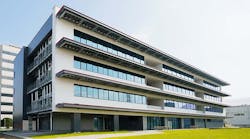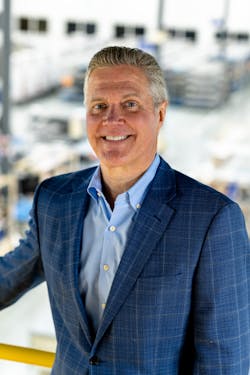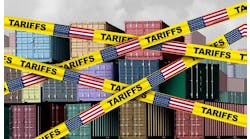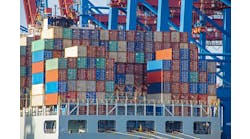Can digital transformation go hand-in-hand with sustainability?
Digital transformation can enable sustainability when done in an environmentally responsible way. Responsible digital transformation can be achieved through digital technologies that support:
• resource efficiency—energy, water, raw materials and reduced waste
• data-driven decisions—make informed decisions that promote sustainability
• remote access and collaboration—reduce the need for travel and associated emissions
• supply-chain transparency—identifying and eliminating practices that are harmful to the environment
• circular economy—leverage AI and IoT to reuse and recycle resources.
Q: Sustainability is now a top business priority. Where does sustainability rank in your organization?
A: At Mitsubishi Electric Automation (MEAU), sustainability is one of our four strategic imperatives for growing and prospering as a business. We define sustainability in terms of both the environment and our workforce. Sustainability in terms of our workforce is all about expanding the talent pool, becoming more diverse and inclusive, providing our employees with an excellent and rich employment experience and increasing the productivity of our workforce so that we can do more with less.
In terms of environmental sustainability, industry is responsible for 30% of global CO2 emissions and 37% of global energy consumption, according to the World Economic Forum.
As a global manufacturer, we provide a wide range of offerings across many industries including:
• power
• transportation
• home appliances
• infrastructure
• manufacturing
• IT/communications.
We have an important role to play in keeping our planet safe for future generations. That’s why Mitsubishi Electric, our parent company, is making sustainability a cornerstone of the company. The goal is to become more sustainable in all aspects from energy consumption to pollution reduction, and adoption of digitization is helping to lead the way toward that goal.
We believe intelligent automation solutions can help address challenges through:
• continuous technological innovation—by challenging our company and our partners to innovate not just for today, but for future generations
• rapid adoption of digitalization—by applying a broad array of technologies in wide-ranging business areas in order to solve environmental issues
• aggressive decarbonization—with the publicly stated corporate goal of achieving environmental sustainability and net-zero emissions by 2050.
As a global leader, we’re sharing our know-how and actively collaborating to find new ways of using automation to address today’s big problems:
• pollution reduction
• shrinking populations
• sustainable resources
• energy consumption.
In all of these areas, Mitsubishi Electric is helping to build a more sustainable society by applying the power of circular digital engineering. Our vision is to:
• consolidate diverse data from all of our business units. We’re in a unique position to gather data-driven, cross-industry business insights.
• analyze consolidated data to identify potential issues and customer needs. This cross-industry data transparency can provide data-driven insights that can help us improve our offerings and support the interconnection of people-centric technology and systems.
• create new value by evolving automation components, systems and integrated solutions based on customer issues and needs. By collecting data from corporate, vendor and customer use cases, we can identify opportunities where new resources can be employed for further improvements.
• return value to customers and help solve society challenges with customers. Environmental sustainability is not something one person, one company or one country can fix. We must all do our part to help mitigate climate change and enable a sustainable future.
Q: Can you give us a few examples of how Mitsubishi Electric Automation helps companies have their digital transformation cake and sustainability, too?
A: Drinking-water and wastewater plants are typically the largest energy consumers for many municipal governments. We’re helping water municipalities across the country move to more automated, data-driven and energy-efficient operations. Companies such as American Water help municipalities through modernization with variable-frequency drives (VFDs) and by replacing the boards and indicator lights of yesteryear with supervisory-control-and-data-acquisition (SCADA) systems such as ICONICS software.
More than 90% of energy consumed in producing and delivering drinking water is used for pumping. Our variable-frequency drives, which are used in all aspects of water operations, provide up to 30% overall reduction in energy consumption.
Modernizing water operations can address many other problems that plague water municipalities. Including issues like pump clogs, water pressure, leak detection and equipment breakdowns.
SCADA systems can bring additional energy savings and also help municipalities to:
• meet compliance with government regulation and reporting requirements, and right-size chemical dosing
• extend the life of equipment through load-balancing of equipment and by bringing visibility of asset performance to know when maintenance will be needed
• help with pond management to be prepared to store excess water in advance of extreme weather events.
Another interesting example is the modernization of LaGuardia Airport, where they are driving comfort in a more intelligent way. Using SCADA, they are able to take building automation to new levels. The system looks at flight data to monitor the number of people in the terminal and know expected peak loads, allowing them to:
• manage HVAC systems based on the passenger volume, saving energy when need is low and keeping passengers and staff comfortable
• monitor waste-bin levels and bathroom maintenance to have appropriate staffing levels
• have proper staffing for vendors.
With these examples, the systems go through continuous commissioning making ongoing adjustments to optimize how the system runs, implement rules and adjust as the systems degenerate.
In addition, our digital world is powered by data centers, which are now considered critical infrastructure by the government.
By 2025, data centers may consume 20% of the world’s energy supply. Roughly half of that energy will be consumed by power and cooling infrastructure. U.S. data-center demand is expected to double by 2030, so there’s no time to waste here.
Our data-center-infrastructure-management (DCIM) solutions bring smaller and better-designed equipment to power and cooling for ongoing energy savings for achieving the highest possible energy efficiency without compromising performance.
Implementing our VFDs in cooling system fan and pump control with permanent-magnet (PM) motors can reduce energy consumption by 50% in data centers. By combining advanced VFD technology with cutting-edge electronics and mechanical technologies, our IT cooling and environmental control increases cooling performance while significantly reducing energy consumption. In addition to equipment, DCIM software can help save up to 75% in CapEx by understanding where investments are best made and to monitor and analyze the results of previous energy initiatives.
The opportunities for modernization are massive!
As you’ve just heard, digital transformation can enable sustainability when done in an environmentally responsible way. Responsible digital transformation can be achieved through digital technologies that support:
• resource efficiency including energy, water, raw materials and reduced waste, space requirements and time/steps. One example of how digital technologies enable resource efficiency is digital-twin technology, which saves material, energy, time and ultimately costs. Our automotive customers can use this technology to significantly reduce production costs and their CO2 footprint.
• data-driven decisions to make faster and more-informed decisions that promote sustainability. Our manufacturing customers can use our ICONICS automation software to monitor and analyze the energy efficiency of an entire production plant. Overall, energy savings of up to 60% are feasible in existing plants.
• remote work and collaboration. Just like every cloud has a silver lining, there is a “green lining” to remote work, in that it reduces the need for travel and associated emissions and helps mitigate the impact of ongoing labor shortages in virtually any industry.
• supply-chain transparency for identifying and eliminating practices that are harmful to the environment. A good example of this is using our technology to remotely monitor electric, water and other critical infrastructure, which also reduces travel and associated emissions.
• circular economy by reusing and recycling resources. Mitsubishi Electric Automation is “going green” with recycled packing materials. By switching from bubble wrap to recycled cardboard we are reducing our carbon footprint, lowering expenses and increasing customer satisfaction. Adding an industrial shredder eliminates 68,000 lb of CO2 annually by repurposing 90% of our incoming shipping cartons and eliminating 100% of the plastic previously used for dunnage in outgoing packages.
Q: How do we move the needle and accelerate green initiatives?
A: The only way to get universal buy-in on sustainability is by helping companies achieve business goals while also solving social challenges.
A perfect example of this is the SUSTIE net Zero Energy Building in Japan. Mitsubishi built and operates this medium-sized office building, which:
• combines energy-generating, regenerating and energy-saving technologies through energy-efficient HVAC and lighting, water heating elevators, solar panels on the roof and other places, and dc versus ac power distribution system for optimized use of solar power
• simultaneously enhances occupant health, comfort and wellbeing
• achieves new levels of digitalization and sustainability. After a year of operation, the SUSTIE net Zero Energy Building reduced energy consumption by 115%, technically creating energy versus using it.
A lot of innovative technologies come together to make this incredible result possible:
• smart devices that capture data from every process and every piece of equipment—the SUSTIE building has approximately 330 data points that monitor and control the building environment
• smarter energy distribution and utilization software to help facilitate the use of clean and flexible energy
• ubiquitous sensors to measure things like temperature, humidity, CO2 concentration, pollen and other variables
• enhanced connectivity, real-time networks and IoT devices such as blinds that control air conditioning use
• data contextualization and visualization software to monitor and improve the total amount of electricity used by the facility and the amount of energy created by solar panels.
This integrated use of power-saving and power-regenerating technologies makes net-zero emissions practical and possible. The design principles used in the SUSTIE building can be applied not just to office buildings, but also to factories, warehouses, public utility systems and the operation of a city’s infrastructure.
Q: What are some of the foundational technologies that support sustainable development?
A: The vision—long-term—is to integrate our products, services and technology across our worldwide business units to enable a global, sustainable smart society. In our business unit, Mitsubishi Electric Automation provides solutions for:
• infrastructure and public utility systems, such as water and wastewater treatment
• energy and facility systems providing energy-saving building management systems and energy-efficient data-center power-infrastructure systems
• industry and mobility enabling smart factories using intelligent edge solutions and industrial networks, as well as intelligent and energy-saving industrial equipment , such as inverters and servo amplifiers.
Q: What role do you think digital natives will play in the greening of everything, and what are you doing to reach Gen Z?
A: Generation Z comprises 68 million individuals in the United States. They’re already entering the workforce, voting and making their voices heard on social media. I, for one, have high hopes for these digital natives. I believe they will help move society forward with regard to environmental sustainability.
This generation is already buying more responsibly and taking into account a company’s beliefs and actions regarding climate change before using their products. A growing majority of them are climate-literate. They’re using social platforms to raise awareness about global warming and to reduce greenhouse gas emissions. Some are even taking legal action and holding states accountable for energy projects that don’t take into account potential climate damage.
More needs to be done to introduce environmental education and action, so the next generation will have a clear understanding of climate change. Mitsubishi Electric Automation is actively engaging educational institutions to both get our technology and solutions into the classroom to educate the workforce of tomorrow on sustainability solutions, and through an aggressive recruitment program to attract millennial and Gen Z recent and future grads to find our next employees.
Q: How do you ensure that your digital transformation enables sustainability?
A: We start as a company and work our way out:
• our company—by 2030, reduce greenhouse gas emissions from factories and offices by 50% or more
• our extended operations—by 2050 net-zero greenhouse-gas emissions in our entire value chain
• our society—we’re not just committed to making our company’s entire value chain carbon-neutral by supporting a circular economy where resources are sustainably sourced, recovered and reused wherever possible. We are also helping our customers create or expand to achieve carbon neutrality with intelligent automation solutions. Our solutions support everything from clean water and sanitation to affordable and clean energy to smart factories and greener logistics.
This is the ideal time to change. We have the knowledge, the technology and the partnerships to change things for the better: for our company, our customers, society and the planet. Please join us.
Sponsored Recommendations
Latest from Financials

Leaders relevant to this article:




